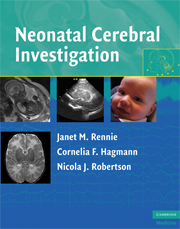Book contents
- Frontmatter
- Contents
- List of contributors
- Preface
- Acknowledgements
- Glossary and abbreviations
- Section I Physics, safety, and patient handling
- Section II Normal appearances
- Section III Solving clinical problems and interpretation of test results
- 7 The baby with a suspected seizure
- 8 The baby who was depressed at birth
- 9 The baby who had an ultrasound as part of a preterm screening protocol
- 10 Common maternal and neonatal conditions that may lead to neonatal brain imaging abnormalities
- 11 The baby with an enlarging head or ventriculomegaly
- 12 The baby with an abnormal antenatal scan: congenital malformations
- 13 The baby with a suspected infection
- 14 Postmortem imaging
- Index
- References
9 - The baby who had an ultrasound as part of a preterm screening protocol
from Section III - Solving clinical problems and interpretation of test results
Published online by Cambridge University Press: 07 December 2009
- Frontmatter
- Contents
- List of contributors
- Preface
- Acknowledgements
- Glossary and abbreviations
- Section I Physics, safety, and patient handling
- Section II Normal appearances
- Section III Solving clinical problems and interpretation of test results
- 7 The baby with a suspected seizure
- 8 The baby who was depressed at birth
- 9 The baby who had an ultrasound as part of a preterm screening protocol
- 10 Common maternal and neonatal conditions that may lead to neonatal brain imaging abnormalities
- 11 The baby with an enlarging head or ventriculomegaly
- 12 The baby with an abnormal antenatal scan: congenital malformations
- 13 The baby with a suspected infection
- 14 Postmortem imaging
- Index
- References
Summary
Clinical presentation of preterm brain injury
Preterm babies who are found to have abnormal brain scans are usually asymptomatic, hence the importance of screening in this vulnerable group. Occasionally a baby develops a bulging fontanelle, shock, and seizures due to a massive intracranial hemorrhage. Encephalopathy is difficult to diagnose in a small ill baby who is ventilated and sedated. The current practice of routine screening was prompted by the high incidence of intracranial bleeding (around 50%) which was first revealed by systematic studies of neuroimaging in preterm babies using computerized tomography (CT) [1,2]. Once ultrasound became widely available cohort studies began in earnest, and continued to show a very high incidence of all grades of intracranial hemorrhage in this group throughout the 1980s (Fig. 9.1). Recently, the incidence has fallen to about 25% overall, with very few significant parenchymal lesions, but the prevalence of disability in affected survivors remains high. The most common lesions requiring assessment in preterm babies now are cerebral atrophy, ventriculomegaly, and delayed cortical development or diffuse white matter injury diagnosed with magnetic resonance imaging (MRI). It is important to remember that brain imaging screening meets very few of the criteria for screening set many years ago by the World Health Organization (WHO) (Table 9.1). In the absence of any effective treatment and no recognizable early stage of disease the aim of cohort screening studies is limited to audit, research, and to provide information for parents.
- Type
- Chapter
- Information
- Neonatal Cerebral Investigation , pp. 173 - 209Publisher: Cambridge University PressPrint publication year: 2008

